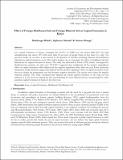| dc.contributor.author | Mukhongo Wafula, Alphonce Odondo, Nelson Obange | |
| dc.date.accessioned | 2020-08-25T10:30:05Z | |
| dc.date.available | 2020-08-25T10:30:05Z | |
| dc.date.issued | 2019-09 | |
| dc.identifier.issn | 2334-2382 (Print), 2334-2390 (Online) | |
| dc.identifier.uri | https://repository.maseno.ac.ke/handle/123456789/2371 | |
| dc.description.abstract | Low capital formation in Kenya, averaging rate 20.13% of GDP over the period 2006-2017 has kept
unemployment rate above 39% with more than 65 per cent of people living on less than $ 2 a day. Yet
previous studies do not have a clear answer to the question of whether increasing bilateral aid/multilateral
aidenhances capital formation or not. This study’s purpose was to investigate the effect of multilateral aid and
bilateral aid on capital formation in Kenya. The study was anchored by Solow (1956) model. Autoregressive
distributed lag estimates for data over 1974-2017 suggested that multilateral aid has positive insignificant
effect on capital formation while bilateral aid has negative significant effect after one year. Error correction
mechanism model estimates suggest that bilateral aid has positive significant effect on capital formation in the
short-run during the programme year but becomes negative thereafter. The results were robust for impulse
response analyses. The study concluded that bilateral aid retards capital formation in the long run but
enhances it in the short-run during the first year.Soliciting for more bilateral aid was recommended in order
accelerate capital formation in Kenya in the short-run. | en_US |
| dc.publisher | American Research Institute for Policy Development | en_US |
| dc.subject | Kenya, Capital Formation, Multilateral Aid, Bilateral Aid | en_US |
| dc.title | Effect of Foreign Multilateral Aid and Foreign Bilateral Aid on Capital Formation in Kenya | en_US |
| dc.type | Article | en_US |

